Chenopodium glaucum (Oak-leaved Goosefoot)
| Also known as: | |
|---|---|
| Genus: | Chenopodium |
| Family: | Amaranthaceae (Amaranth) |
| Life cycle: | annual |
| Origin: | native |
| Habitat: | sun; disturbed soil; roadsides, gravel pits, railroads, gravelly shores, waste places, |
| Bloom season: | July - September |
| Plant height: | 2 to 16 inches |
| Wetland Indicator Status: | GP: FAC MW: FACW NCNE: FACW |
| MN county distribution (click map to enlarge): |  |
| National distribution (click map to enlarge): |  |
Pick an image for a larger view. See the glossary for icon descriptions.
Detailed Information
Flower: 


![[photo of flower clusters]](/udata/r9ndp23q/pd/chenopodium-glaucum-004-t.jpg) Numerous tiny flowers are tightly packed in round clusters (glomerules) less than 1/8 inch diameter in a spike-like arrangement at the top of the stem and along stalks up to 4 inches long arising from leaf axils. Flowers lack petals, have 1 to 3 short stamens and an oval, green ovary with a 2-parted style at the tip. Cupping the flower is a green calyx with usually 3 rounded lobes less than 1 mm long, sometimes 4 lobes.
Numerous tiny flowers are tightly packed in round clusters (glomerules) less than 1/8 inch diameter in a spike-like arrangement at the top of the stem and along stalks up to 4 inches long arising from leaf axils. Flowers lack petals, have 1 to 3 short stamens and an oval, green ovary with a 2-parted style at the tip. Cupping the flower is a green calyx with usually 3 rounded lobes less than 1 mm long, sometimes 4 lobes.
![[close-up of flower clusters]](/udata/r9ndp23q/pd/chenopodium-glaucum-083016-s1-t.jpg) Bracts are leaf-like but may be absent especially on the upper half or more of a spike. The calyx and stalks are smooth and hairless; bracts may be mealy-white especially on the underside.
Bracts are leaf-like but may be absent especially on the upper half or more of a spike. The calyx and stalks are smooth and hairless; bracts may be mealy-white especially on the underside.
Leaves and stems: 


![[photo of leaves]](/udata/r9ndp23q/pd/chenopodium-glaucum-94530-3-t.jpg) Leaves are alternate, typically ½ to 2 inches long, up to about ½ inch wide, egg-shaped to oblong in outline, with 2 to 4 shallow lobes or large teeth on each side, the lobes/teeth rounded to pointed, the leaf tip also rounded to pointed, the base wedge-shaped tapering to a short stalk.
Leaves are alternate, typically ½ to 2 inches long, up to about ½ inch wide, egg-shaped to oblong in outline, with 2 to 4 shallow lobes or large teeth on each side, the lobes/teeth rounded to pointed, the leaf tip also rounded to pointed, the base wedge-shaped tapering to a short stalk.
![[photo of leaf underside]](/udata/r9ndp23q/pd/chenopodium-glaucum-15-1-t.jpg) Surfaces are hairless, the upper surface smooth or sparsely white-mealy with the underside densely white-mealy. Color is typically blue-green. Stems are branched from the base, erect or more often prostrate from the base, green to red or red striped, may be white-mealy especially towards the base but typically smooth on the upper stem.
Surfaces are hairless, the upper surface smooth or sparsely white-mealy with the underside densely white-mealy. Color is typically blue-green. Stems are branched from the base, erect or more often prostrate from the base, green to red or red striped, may be white-mealy especially towards the base but typically smooth on the upper stem.
Fruit: 
![[photo of developing fruit]](/udata/r9ndp23q/pd/chenopodium-glaucum-7216-s1-t.jpg) Fruit is a dry seed enclosed in the persistent ovary shell (pericarp) that matures from green to brown and loosely wraps the seed. Fruit in the glomerule is mostly arranged horizontally with some vertical. Seeds are flattened oval to round, up to 1.1 mm long, shiny dark reddish-brown with a wrinkled and pitted texture.
Fruit is a dry seed enclosed in the persistent ovary shell (pericarp) that matures from green to brown and loosely wraps the seed. Fruit in the glomerule is mostly arranged horizontally with some vertical. Seeds are flattened oval to round, up to 1.1 mm long, shiny dark reddish-brown with a wrinkled and pitted texture.
Notes:
Oak-leaved Goosefoot, known in some references as Oxybasis glauca, is an annual found mostly in disturbed soils such as gravel pits, empty lots, dumps, river banks, marly, sandy or gravelly shores, and the occasional garden. It is distinguished from other Chenopodium species by leaves that are typically small, lance-oblong in outline with a few shallow lobes or large teeth around the edges, usually blue-green in color, and densely white-mealy on the underside. The flower or fruit clusters are not white-mealy, and the calyx has only 3(4) lobes. There are two recognized varieties, both of which have been found in Minnesota: var. glauca is of European origin, lacks leaf-like bracts in the flower clusters and has rounded teeth/lobes on leaves; var. salinum is native to North America, has leaf-like bracts throughout the flower clusters and has pointed teeth/lobes on leaves.
It is one of the easier Chenopodium species to identify. By comparison, other species may have leaves that are more deeply lobed or not lobed at all, not white-mealy on the underside, are white-mealy in the flower and fruit clusters, have 5 calyx lobes, and/or seeds have a smooth surface. Of note is that, while the leaves of Oak-leaved Goosefoot are typically small and the plant rather sprawling, in cultivation it can be quite robust with more erect stems and larger leaves.
Native Plant Nurseries, Restoration and Landscaping Services ↓
More photos
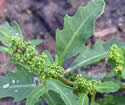 Oak-leaved Goosefoot plant
Oak-leaved Goosefoot plant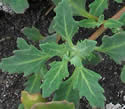 Oak-leaved Goosefoot plant
Oak-leaved Goosefoot plant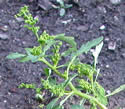 Oak-leaved Goosefoot plant
Oak-leaved Goosefoot plant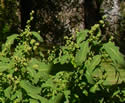 robust plants in cultivation
robust plants in cultivation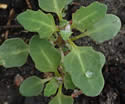 emerging in spring
emerging in spring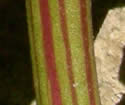 stems are often red-striped
stems are often red-striped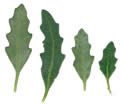 leaf scan
leaf scan
Photos by Peter M. Dziuk taken at various locations across Minnesota.
Comments
Have you seen this plant in Minnesota, or have any other comments about it?
on: 2023-06-21 10:33:21
I believe this is the plant that I used to think was just an interesting type of Lambs quarters. It is not as prolific as the former, being about one in every 50 weeded lambs quarter weeds in my raised garden bed.






